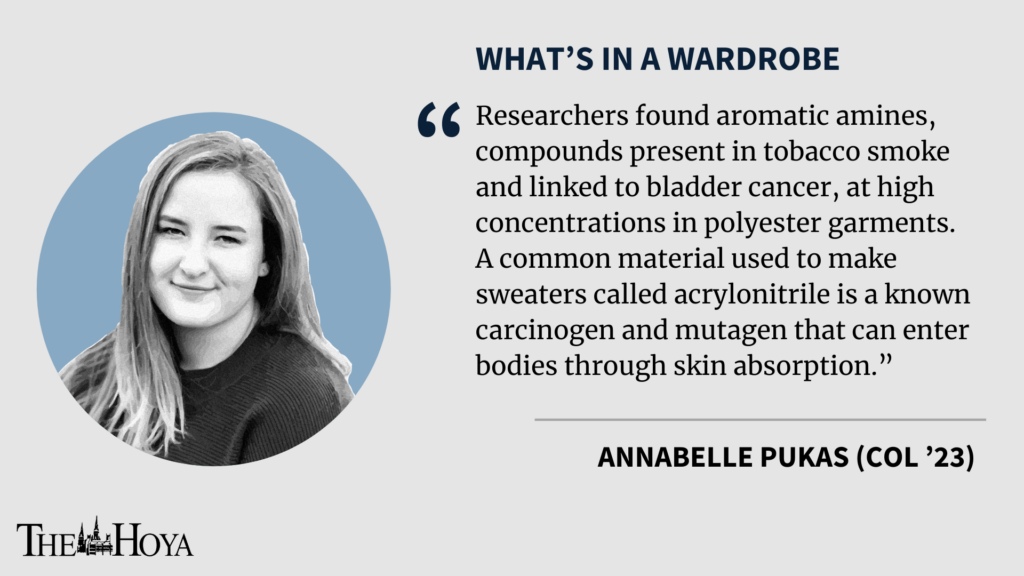If the average person spends 20 minutes each day getting dressed, they will spend around 238 days of their lives putting on clothes. Yet, almost no one considers the lifelong health implications their clothes might have.
Often unknown, around 60% of all clothing in circulation is made of synthetic fibers, and over 8,000 different chemicals are used in the transformation of raw materials into market-ready clothing. Skin, the body’s largest organ, is permeable to the chemicals present in the clothing we wear, like formaldehyde, ammonia and fire retardants. Yet, this topic is under-discussed.
Garments have thousands of lingering chemicals at the time of purchase, some of which are known carcinogens, according to a 2015 report from Stockholm University. For example, researchers found aromatic amines, compounds present in tobacco smoke and linked to bladder cancer, at high concentrations in polyester garments. A common material used to make sweaters called acrylonitrile is a known carcinogen and mutagen that can enter bodies through skin absorption. Additional toxic chemicals, such as dibenzofurans, transfer from textiles to skin, and with high exposure, they can affect the liver, blood, skin, gastrointestinal, endocrine, immune, nervous and reproductive systems.
While wearing synthetic garments presents harms to physical health, synthetic textile manufacturing is even more dangerous as it exposes textile workers to harmful chemicals at high rates. Manufacturing workers who were exposed to synthetic materials had a higher risk of developing postmenopausal breast cancer, reported by Canadian Occupational & Environmental Medicine. For each 10-year increase in exposure to acrylic fibers during manufacturing, women were almost eight times as likely to develop breast cancer than the general population.
Consumption of synthetic materials puts the consumer at risk while subjecting workers to potentially severe health complications.
Not only are women more likely to work as textile workers, but they are also extremely likely to experience societal expectations of dress. The assumption that people with breasts should wear bras might also lead to serious health conditions. Modern bras are typically made of synthetic materials like nylon, spandex or polyester and many have polyurethane padding, which is a form of plastic.
“Premenopausal women who do not wear bras had half the risk of breast cancer compared to bra users,” according to a 1991 survey published by the department of epidemiology at the Harvard School of Public Health.
In addition to the risks associated with items, the way clothes are cared for also jeopardizes health. Washing items does not guarantee that chemicals will be removed. A 2007 analysis performed by the Environmental Working Group detected “a range of hormone-disrupting contaminants” in laundry wastewater, originating from both the clothes and specific chemicals like phthalates in laundry soaps and detergents.
Dry cleaning seems to be no better. The Department of Health and Human Services suspects perchloroethylene, the chemical most often used in dry cleaning, to be a carcinogen that a University of Albany and New York Attorney General study found correlates with higher levels of kidney cancer and neurological effects.
Synthetic garments continue to “off-gas,” meaning they will release chemicals throughout their lifetime. Yet, despite the pervasiveness of toxic materials, consumers can still minimize exposure. Natural clothing materials like hemp, cotton or linen tend to be safer fabrics, and buying OEKO-TEX-certified clothing can increase consumer confidence in products by guaranteeing materials were found to be absent of dangerous chemicals. Further, shopping secondhand for both natural and synthetic items is also beneficial, since buying secondhand generally means a percentage of harmful chemicals have been washed out over time.
In terms of clothing care, using green, perc-free dry cleaning instead of typical dry cleaning methods can be an easy and healthier alternative. Sustainable detergents are another way to reduce the amount of toxic chemicals in a home. Dropps, a safe laundry detergent brand, won the Environmental Protection Agency’s Safer Choice Partner of the Year award in 2017 by maintaining strict health and environmental safety standards. Furthermore, in place of a fabric softener, wool dryer balls can be used with safe essential oils to add fragrance to laundry.
Beyond individual action, the fashion industry must change to create healthier clothing. Brands should shift their production focus from synthetics to natural fabrics, invest in research surrounding the health consequences of the chemicals they use and appropriately label their garments when toxicity may be associated with the textile.
An informed consumer is the healthiest consumer, and brands must provide information to their customers so they can make informed decisions about what they put on their bodies.
Until the fashion industry assumes responsibility for its products, consumers must independently arm themselves with knowledge regarding the influence their clothes have on their health.
Annabelle Pukas is a sophomore in the College. What’s in a Wardrobe appears online every other Thursday.










Charcy • Nov 5, 2020 at 10:13 pm
Insightful.